Positive Body Awareness
Andrew Cook MSc RCST
Transformational Bodywork
 History of CST
History of CST
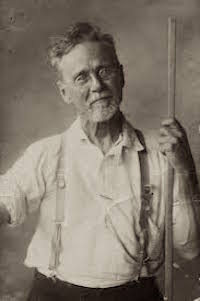
Andrew Taylor Still
Andrew Taylor Still
Craniosacral Therapy (CST) started off as Cranial Osteopathy (which itself is a branch of Classical Osteopathy) ,and then diverged from the Osteopathic mainstream, whilst retaining many elements of the philosophy of Osteopathy.
Osteopathy was devised by Andrew Taylor Still (1828-1917). A surgeon-doctor during the American Civil War, Still became disillusioned by the heroic medicine of the time (consisting mainly of opium and mercury salts) after he lost two of his children to meningitis. Osteopathy has a philosophical foundation in the New Thought movement, followed by people such as Ralph Waldo Trine. In turn, this owes many of its principles to the writings of Emmanuel Swedenborg, the 18th century Swedish scientist-engineer-philosopher and Christian mystic. AT Still was also strongly influenced by his childhood contact with the Shawnee American Indians that he met and played with on his parent's farm. He had a deep spiritual belief that informed all of his actions, and both traditional Osteopathy and CST have continued that, having a fundamentally Vitalist view of the body.
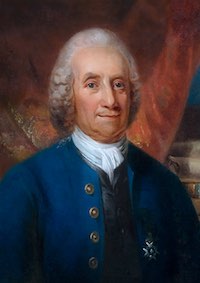
Swedenborg
This viewpoint doesn't necessarily have to be held by the patients, but many people do gravitate towards CST because it offers a more spiritual viewpoint of health. Most importantly - regardless of your belief system or point of view - the principle of wellbeing does have substantial practical implications as to how the practitioner approaches a treatment.
...he believed that if the rivers and streams of the landscape of the human body were unclogged and free flowing, then its ecology would be healthy...
AT Still developed Osteopathy as a drug-free, manual therapy capable of treating even the most severe of illnesses. At a time when communicable diseases such as cholera, typhoid, diphtheria, measles and meningitis were largely fatal, he achieved near 100% rates of remission in these and in many other physical illnesses. The principle he applied was that - if the body's fluid circulatory systems and nervous system were free to work as they should, then the body was capable of healing itself. With the concept of wellness comes the idea that, in most cases, disease arises only when there is fertile ground for pathogens to get out of control. The human body has many bacteria living in it all the time, and everyday things like coins and banknotes are covered with sometimes very dangerous bacteria and viruses. So an important question is - what is the difference between the times we get ill compared to the times we remain healthy? Most bacteria are positively beneficial (or at least neutral) to our health, and most of the time even pathogens do not affect us. So another way of looking at this is to say that pathogens are opportunistic, and will multiply if they have fertile ground to do so... i.e. the body is already ill before what we think of as illness actually starts.
It is interesting that the inventor of the Smallpox vaccine, Edward Jenner, was uncertain at the end of his life whether he had helped humankind or caused more suffering. Similarly, Louis Pasteur, one of the founders of modern Germ Theory (i.e.the medical focus on pathology) recanted on his deathbed, saying "The terrain is everything". AT Still had similar feelings, and believed that if the rivers and streams of the landscape of the body were unclogged and free flowing, then its ecology would be healthy. The main protagonists in the original debate between illness (Germ Theory) or wellness (Cellular Theory) as a medical paradigm (Louis Pasteur, Antoine Béchamp and Claude Bernard) were contemporary with AT Still.
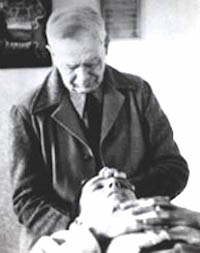
WG Sutherland
William Garner Sutherland
Cranial Osteopathy was originally devised by AT Still's student, William Garner Sutherland (1873-1954) in the 1920's and 30's. His first inkling that there might be some motion of the Cranial system came when he was looking at the bones of the skull and had the idea that the temporal bone (the bone that contains the ear) looked very much like the gills of a fish. This was extraordinarily prescient, since modern comparative biology has identified the human ear as having evolved from the foremost lateral line pressure sensor in primitive fish - and that sensor was located in the area of the gills. For Sutherland this became an issue of the extra 5% - or how to help those people who walk into every therapist's practice who just don't respond to treatment. Reading his collected diaries shows how dedicated he was to helping others and how prepared he was to experiment. Following the principles of AT Still, this experimentation was always guided by the ancient medical aphorism ""first do no harm".
Sutherland experimented for the 10 years after graduating with all kinds of more physical approaches. The first big breakthrough came when he decided to experiment on himself, adapting a leather American football helmet by adding various screws and other means to restrict the motion of his own Cranial bones. At one stage his wife (who assisted him in this project) was terrified for his life as the restrictions he imposed on his Cranial bones created temporary personality changes, mental disorders and a wide range of sometimes serious physiological illnesses for as long as the restriction was applied. For example, compression of the mastoid processes induced projectile vomiting.
...continued to refine his relationship with these internal movements, continually seeking an improvement in clinical outcomes...
The second and most important big breakthrough came when he decided to just sit and feel any movements that were there, instead of finding ways to physically move Cranial bones. Having first experienced a cranial rhythm, he then discovered that he could work with that rhythm to alter the relative alignment of Cranial structures. Over the years, he continued to refine his relationship with these internal movements, continually seeking an improvement in clinical outcomes and also seeking an understanding of what he was working with. Initially Sutherland focused on bones, then realised that the bones are just spacers in a membranous reciprocal tension system - what we would today call a Tensegrity structure. This Cranial rhythm that Sutherland first identified is now called the Cranial Rhythmic Impulse (CRI) and has a cycle time of between 4 and 12 seconds.
As he continued to develop Cranial techniques up to his death in 1954, Sutherland moved towards more and more subtle work - firstly to fluids (finding that these informed the activity of membranes), then to the the "fluid moving within fluid" - possibly some kind of electrical phenomena, and eventually to "liquid light". And the rhythms he was working with also changed, as he found that the longer rhythms - some up to a minute or more for a single cycle - were more fundamental and could potentially work far deeper into the body and bring about changes in a more profound way. Osteopaths in the USA including Viola Fryman, Harold Magoun, Anne Wales and Rollin Becker continued to develop his work during his lifetime and after his death.
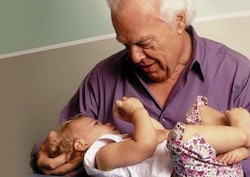
JE Upledger
Dr John Upledger
Craniosacral Therapy came about when John Upledger (1932-2012), an Osteopath in Florida, found he was having some remarkable effects on children suffering from a range of problems such as cerebral palsy, ADHD/ADD, and dyslexia by applying Cranial techniques. He was so excited that he wanted all of the other doctors in his practice to use the same approach so that they could help more children. He started a research program to produce some evidence of the effects he was seeing. But to his dismay and the dismay of the parents, a local journalist got a headline scoop of Experiments on Children, and the research program was shut down. The data that was collected was published as it stood, but is incomplete and does not meet the standards required for medical evidence. Meanwhile, none of Upledger's medical colleagues were interested, so he started to train parents and some of his practice nurses and physiotherapists. He quickly found that - in general - the less medical training people had, the easier they could pick up the necessary manual skills, possibly because they had no preconceptions as to what was happening in the body or what is or is not possible. This led to the formation of the Upledger Institute in 1975 - the first Cranial school outside the Osteopathic profession. Dr John Upledger - true to the tradition he came from - continued to experiment and combine different approaches throughout his life, and taught a package of techniques that he found clinically useful, with a core of Cranial work.
The remarkable qualities of CST were soon recognised, and other osteopaths and other health professionals also opened CST schools in the USA, UK and Germany. Franklyn Sills, an ex Osteopathic student and Polarity Therapy teacher, went back to Sutherland and Becker's original work and is one of the main developers of what is now called Biodynamic CST. James Jealous is possibly one of the main modern-day teachers and developers of the Biodynamic approach in the Cranial Osteopathic field.
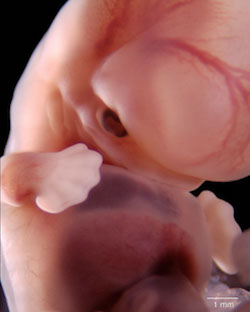
44 days
The Present and Future...
Times have changed a lot since the days of AT Still. Firstly, there is a mainstream medical system that caters for life-threatening illnesses and has a virtual monopoly (backed up by legal force) on the treatment of serious medical conditions. Secondly, most people have very different bodies - the nutrition has changed, there is less physical work (even wealthy people would ride horses in the 19th century), and the world is much safer for individuals. So the emphasis of the practice and training in Cranial work has also had to adapt to this change.
CST continues to evolve rapidly - and CST courses today are very different from courses 20 or even 10 years ago. Principles of embryology and the formative forces that grow a human have been an important focus of CST for maybe 30 or 40 years, and that importance continues to increase. One could say that the development of pre-natal body psychotherapy by Emmerson and Castellino (e.g. see The Association for Prenatal and Perinatal Psychology and Health) would not probably have developed without the influence of CST. And now birth process work is in turn influencing CST. Particularly over the past 15 years (but also from the body-movement therapies that grew in Germany in the 1930's) many progressive bodywork and psychotherapy modalities have found that the line between body (physiology/pathology) and mind is truly invisible - there is no distinction. We live in an organism in which body and mind have evolved as an integral whole right from the beginning. So CST in particular has embraced the trauma work of Peter Levine and more recently the Polyvagal theory of Stephen Porges; and CST practice lies (in a modern, pigeonholed world) slightly uncomfortably in ground that overlaps both pure bodywork (working with physical, physiological and structural issues) and body psychotherapy (because we live in a body-mind, in which physical evolution has always included an embedded consciousness). However, the fundamental position that CST approaches this from is that "everything is in the body". e.g. the dialoguing techniques devised by John Upledger (Somato-Emotional Release™) are based on a close monitoring of the state of the body and the state of the Cranial rhythm, and so are quite distinct from most psychotherapy approaches.
Modern research
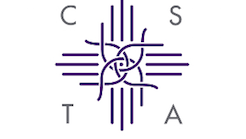
Research into the clinical effectiveness of CST only started in the past few years, and this continue to grow - e.g. see the research page on the Craniosacral Therapy Association Website, and the Craniosacral Research Blog.
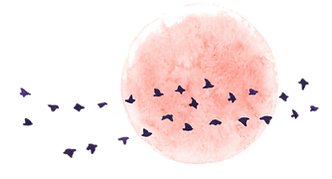
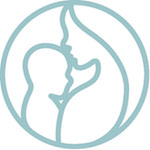


<< ¦ Top ¦ Menu ¦ Front page ¦ Body-Mind ¦ CST/Clinic ¦ Contact ¦ Site Map ¦ Search
all content © Andrew Cook, Norwich UK, 2021



